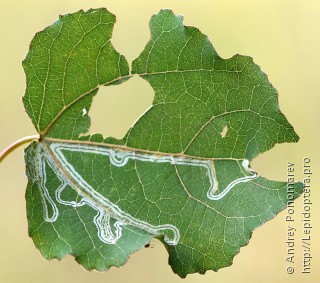Researchers from the University of Florida study leaf-mining moths of Central Africa
Community and Forum → Blog → Researchers from the University of Florida study leaf-mining moths of Central Africa
Lev Bely, 28.12.2012 23:11
In the Congo, where mammals and birds are nearly extinguished by hunters, somewhere deep in the rain forests everything is full of life, which is all buzzing, crunching and peeping, and these sounds truly dominate everyone happened to be there.
The area is rather far away from any political anxiety so keeps out of all the storms, and the local insect biodiversity still remains unknown. A new monographic book recently published in Zootaxa presents actual data on the Congo's insect biodiversity by researchers from the University of Florida and the Royal Museum of Central Africa in Belgium. They tried to cover the situation with insects in this part of Central Africa, where the habitat has been being destroyed more and more every year.
The authors focused on leaf-mining moths, amidst which they named 41 species what's nearly twice as many as previously known there. Leaf-mining moths can be found everywhere in the world and they play an important role in agriculture since some of them are pests, whilst others on the contrary constrain expansion of invasive plants. Some species are even able to slow aging in plants.
“When we began this project, we had no idea how many species would be out there,” said co-author Akito Kawahara, assistant curator of Lepidoptera at the Florida Museum of Natural History on the UF campus. “In a two-week field trip, we discovered nearly 50 potentially new species, which is really surprising. There is still an enormous amount of life out there that we know very little of.”
Jurate DePrins, the lead author of the study, has been working on leaf miners for almost 10 years and about 5 years ago he started working with Kawahara. As the name suggests, the small moths burrow within leaves as larvae, making them particularly difficult to find. Adult moths measure only about 2 to 5 millimeters in length, but they can be extraordinarily beautiful with colorful markings and metallic scales, Kawahara said.
“The caterpillars are completely flat so they can live inside the thin leaf,” Kawahara said. “If you think of a regular caterpillar and then you squished it and shrunk it, that’s what they look like.”
After the larvae gathered, researchers raise them to adult stage right on the spot in the course of their expedition. It takes just a week for some species.
“It’s so hard to tell what’s actually happening because they’re so small and they get overlooked, but if you look at what is happening inside a leaf under a microscope, it’s just an incredible world,” Kawahara said. “You’ll see a tiny wasp larva living within a caterpillar, and another, even smaller wasp larva living inside that larger wasp larva that is inside the moth larva. It really opens your eyes to this incredible, unknown world and makes you think, ‘What is going on here?’ It’s truly amazing.”
Leaf-mining moths have unusual survival strategies, poorly understood by researchers, Kawahara said. Relatives of the new species are known to make “green islands,” patches of green leaves found in a pile of brown leaves. When leaves fall from trees and turn brown, the caterpillars preserve the leaves they live in and keep them green.
“Some of these caterpillars actually have the ability to control plant tissue and prevent aging in the plant,” Kawahara said. “Now we’re trying to actually understand the mechanism behind how they actually do it.”
The subfamily Lithocolletinae explored in the study is one of the oldest-known Lepidoptera subfamilies, first described by Carl Linnaeus in 1758. The only book that covers the subfamily species in Africa was published in 1961.
“This is really one of the first major revisions on species level of any of the African members of this large family,” said Donald Davis, a research entomologist at the National Museum of Natural History, Smithsonian Institution. “Any of their discoveries is going to be important because it greatly increases what we previously knew, how little we knew.”
While many large organisms are being studied, not many researchers focus on the smaller organisms, Davis said. Information about Lithocolletinae is needed to understand which species may be agricultural pests or used to control invasive plants.
“It’s an unknown fauna and so they’ve made a major step to start telling us something about this biota,” Davis said. “Because the moths are herbivores, they have both beneficial and detrimental benefits. It’s one of the things we get a lot of questions about.”
University of Florida, http://news.ufl.edu
Photo: Phyllocnistis labyrinthella leaf mine on a common aspen
All the rest posts on: Africa, Pests, science, new species, agriculture, Smithsonian Institution, ecology
Comments
New comment
Note: you should have a Insecta.pro account to upload new topics and comments. Please, create an account or log in to add comments.
* Our website is multilingual. Some comments have been translated from other languages.
Random species of the website catalog
News
- 02.03.2025: Moscow Insect Fair: New section on the Insecta.pro Website
- 31.12.2024: If you need to upload a lot of photos to Insecta.pro website
- 10.12.2024: Новое поле в «Поиске энтомологов»
New photos (13.03.2025)
Fresh from the community
- 17:11, V. Kolesnikov: Stenoptilia pneumonanthes?...
- 22:21, P. Khramov: Geometridae / Oleg Semin → Calcarit...
- 17:10, N. Grebennikov: Calcaritis pallida ....
Popular insects
Recommended blog topics
- ICZN Election of Commissioners
- Entomological seminar in Moscow on November 13
- 20th International Insect Fair in Moscow (Russia, October 2023)
- Wildlife Photography Day at the Central House of Artists, Moscow, December 15th




























